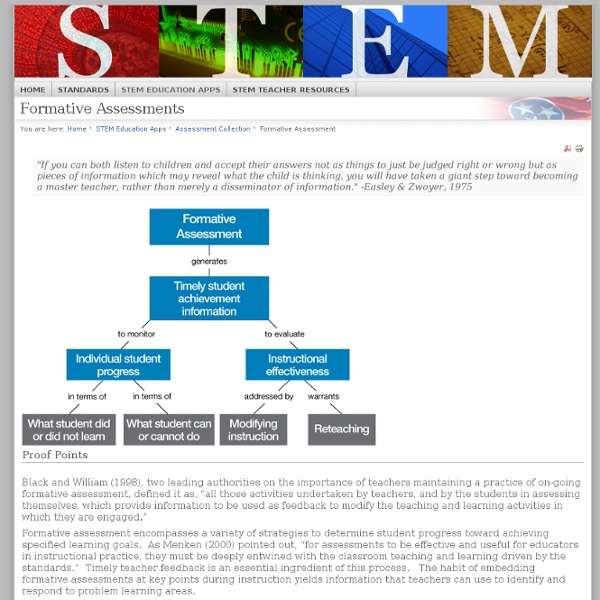Formative Assessments

The concept of formative assessment. Boston, Carol
Carol Boston ERIC Clearinghouse on Assessment and Evaluation University of Maryland, College Park While many educators are highly focused on state tests, it is important to consider that over the course of a year, teachers can build in many opportunities to assess how students are learning and then use this information to make beneficial changes in instruction. This diagnostic use of assessment to provide feedback to teachers and students over the course of instruction is called formative assessment. It stands in contrast to summative assessment, which generally takes place after a period of instruction and requires making a judgment about the learning that has occurred (e.g., by grading or scoring a test or paper). This article addresses the benefits of formative assessment and provides examples and resources to support its implementation. Purpose and Benefits of Formative Assessment Examples of Formative Assessment Teachers might also assess students' understanding in the following ways:
Summative assessment
Summative assessments are cumulative evaluations used to measure student growth after instruction and are generally given at the end of a course in order to determine whether long term learning goals have been met. Summative assessments are not like formative assessments, which are designed to provide the immediate, explicit feedback useful for helping teacher and student during the learning process. High quality summative information can shape how teachers organize their curricula or what courses schools offer their students. Although there are many types of summative assessments, the most common examples include: State-mandated assessments District benchmark or interim assessments End-of-unit or -chapter tests End-of-term or -semester exams Scores that are used for accountability for schools (AYP) and students (report card grades) According to the North Carolina Public Schools, summative assessments are often created in the following formats:
What Are Formative Assessments and Why Should We Use Them?
"Informative assessment isn't an end in itself, but the beginning of better instruction." —Carol Ann Tomlinson Traditionally, we have used assessments to measure how much our students have learned up to a particular point in time. Since formative assessments are considered part of the learning, they need not be graded as summative assessments (end-of-unit exams or quarterlies, for example) are. When I work with teachers during staff development, they often tell me they don't have time to assess students along the way. Formative assessments, however, do not have to take an inordinate amount of time. Using a Variety of Formative Assessments The National Forum on Assessment (1995) suggests that assessment systems include opportunities for both individual and group work. Often, the opportunity to work with others before working on their own leads students toward mastery. Types of Assessment Strategies How to Use the Assessments in This Book In addition, for many strategies you'll find:
Classroom Assessment | Basic Concepts
A. Formative vs. Summative Assessments Classroom assessments can include a wide range of options -- from recording anecdotal notes while observing a student to administering standardized tests. Formative assessments are on-going assessments, reviews, and observations in a classroom. Summative assessments are typically used to evaluate the effectiveness of instructional programs and services at the end of an academic year or at a pre-determined time. The following table highlights some formative and summative assessments that are common in K12 schools.
Related:
Related:



